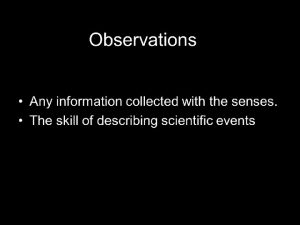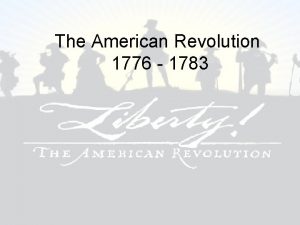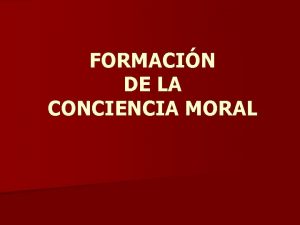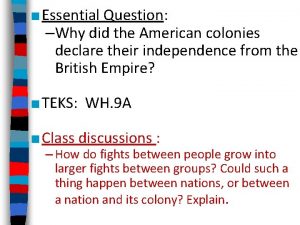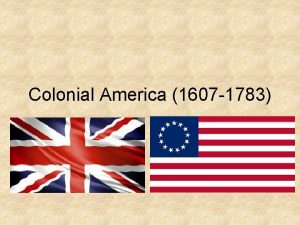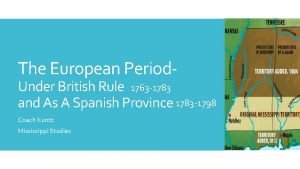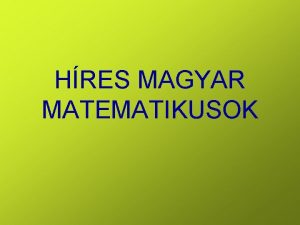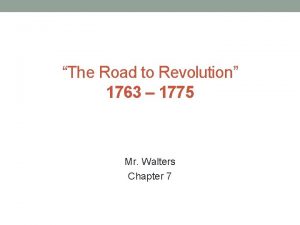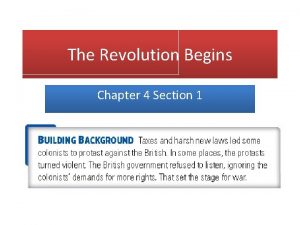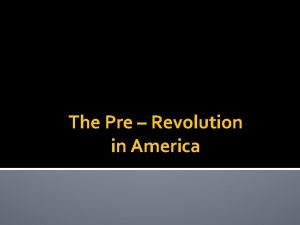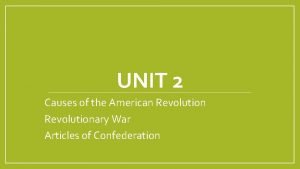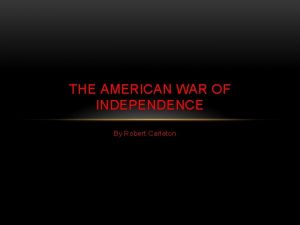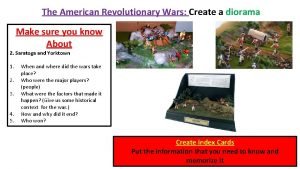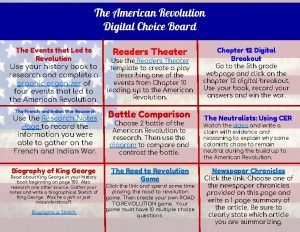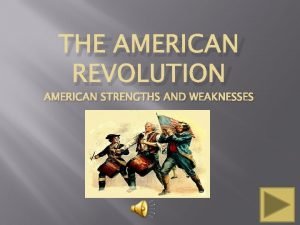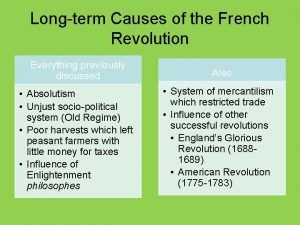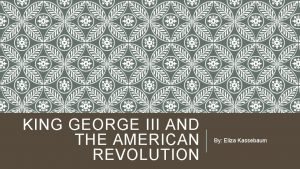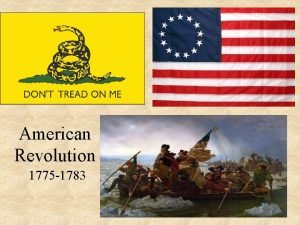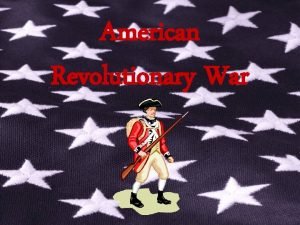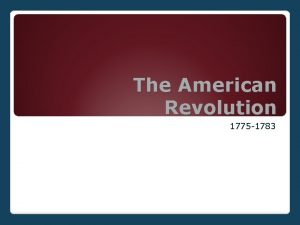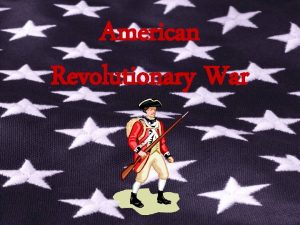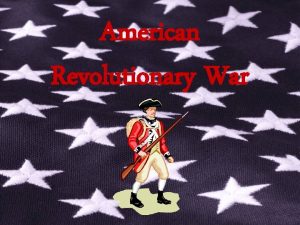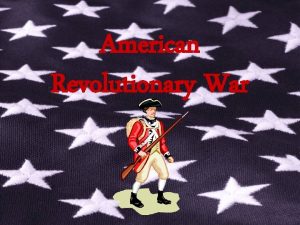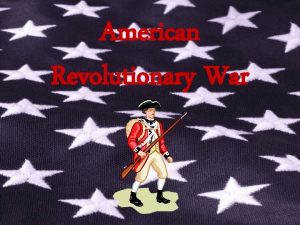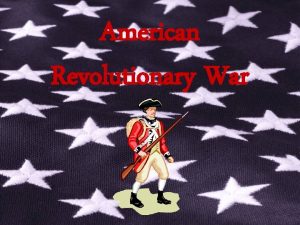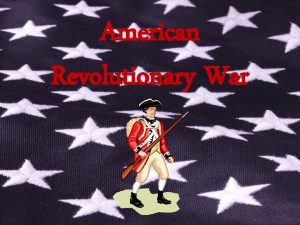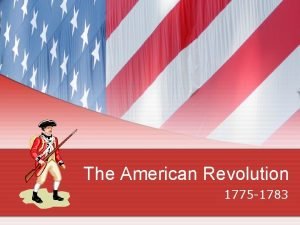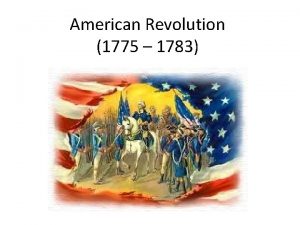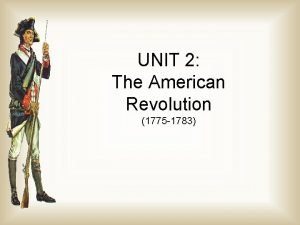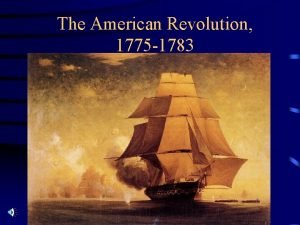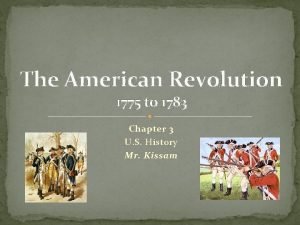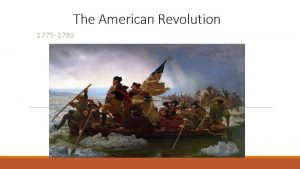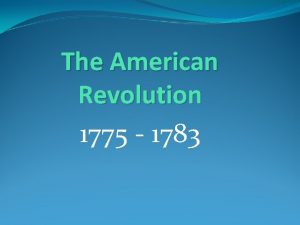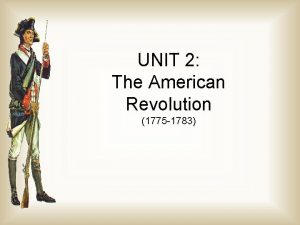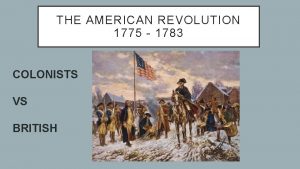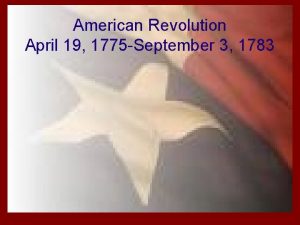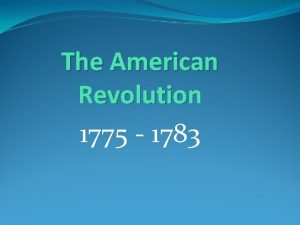American Revolution 1775 1783 The Coming Revolution First



























- Slides: 27

American Revolution 1775 -1783

The Coming Revolution • First Battle – Lexington and Concord, Mass. – April 19, 1775 • • § “Shot Heard Round The World” British army against Militia (Minutemen) Mecklenburg Resolves – May 31, 1775 declared that British rule in the colonies was ended • Second Continental Congress – May. June, 1775 – Philadelphia A. Created a Continental Army B. Chose George Washington to command C. Olive Branch Petition

Second Continental Congress

Bunker Hill Battle of Lexington

War in North Carolina 1775 -1776 Opposing Sides • 1. Patriots – in favor of independence, many former Regulators • 2. Loyalists/Tories – wanted to remain part of England - political elite, recent immigrants • 3. Population is One/Third Patriot, One/Third Loyalist, One/Third Neutral at start of war – majority has become Patriot by end of war

• Halifax Resolves – April 12, 1776 – – document that makes NC the first colony to officially support independence Some Trivia: Two dates on North Carolina’s state flag üMay 20, 1775=Mecklenburg Resolves üApril 12, 1776=Halifax Resolves

Declaring Independence • Common Sense – published January 9, 1776 (pg. 125 in textbook--The Power of Words and Ideas) • Thomas Paine • B. First written work to state that the colonies should be independent • Declaration of Independence • A. Approved by Second Continental Congress on July 4 th, 1776—signed by John Hancock President of the 2 nd Continental Congress • B. Not signed until August 2 nd, 1776 • C. Contained three main ideas • 1. All men possess Unalienable Rights • 2. England had violated the colonists’ rights • 3. Colonies had the right to break away from England

THE DECLARATION OF INDEPENDENCE • 4. People have “certain unalienable rights” (rights that can not be taken away) – a. Life – b. Liberty – c. Pursuit of happiness • 5. People establish government to protect those rights. • 6. Government derives power from the people. • 7. People have a right and a duty to change a government that violates their rights.

Picture of the Original Document Declaration of Independence

• D. Written by Thomas Jefferson – originally contained a clause outlawing slavery – southerners would not approve • E. Declaration of Independence did not address the rights of slaves or women – New England states abolished slavery on their own by 1784 • Signers from NC – William Hooper, Joseph Hewes, John Penn • Signers of the Declaration of Independence were committing treason and it was punishable by death

Signing of Declaration of Independence Thomas Jefferson

Most Indians sided with British or were neutral Attakulla Lord Dunmore’s Proclamation – gave freedom to any slave that fought for England Blacks were not allowed to fight in the American army at first Eventually, one out of every seven American soldiers was black

Molly Pitcher

Deborah Sampson Abagail Adams Deborah Sampson – fought disguised as a man for two years Abigail Adams – first women’s rights crusader

Advantages • • • British Professional leaders Best army in world Best navy in world More financial resources Americans Fighting for a cause (Independence) Support of the people Fighting on their own land

War in the North • A. 1775 -1776 – British win most battles • B. Low point of war for Patriots – early winter of 1776 • 1. Battle of Trenton – December 25, 1776 • 2. Hessians – German mercenaries • C. Turning point of war in Northern colonies was the Battle of Saratoga – October 17, 1777 • 1. Defeated British plan to split the colonies in half • 2. France and Spain join the Patriots against England

Washington crossing the Delaware Battle of Trenton

Battle of Saratoga

1. 3 types of troops: Continental Army, militia, partisans or “irregulars” 2. Valley Forge – Winter of 1777 -78 – Americans did not have enough food, clothing, or shelter. They had also not been paid for months. 2000 died. Ages ran from 12 to 60 – Friedrich Von Steuben 3. Alliance with France in 1778 • • Marquis De Lafayette sent supplies, money, troops, navy

Valley Forge Marquis De Lafayette Steuben trains the Americans

War in the South After Saratoga (turning point of the war), British focus on the southern colonies – most loyalists in South • A. British are successful at first, winning most southern battles • B. Patriots had to resort to Guerilla warfare – hit and run, (terrorist-style) – Francis Marion (used as model for “The Patriot”) – Partisans • C. Nathanael Greene became commander of Continental Army in the South • D. British were commanded by Charles Cornwallis – decide to move north through North Carolina to meet main British army in the North.

• Battle of Guilford Courthouse – March 15, 1781 – Greene goes to NC and waits for Cornwallis at Guilford County Courthouse (now Greensboro) – British win, but are badly weakened— 1/4 of British troops dead or badly wounded

End of War • Cornwallis is surrounded by American and French armies and French navy at Yorktown, Virginia • British surrender on October 20, 1781 – last major battle of war • Some trivia: The British army band played “The World Turned Upside Down” • British decided war was not worth the cost • Treaty of Paris is signed in 1783 – America gets independence

Francis Marion – The Swamp Fox Guilford Courthouse

Nathanael Greene Charles Cornwallis

British surrender at Yorktown

Revolution’s Aftermath • NC’s economy was wrecked and the state had a large war debt - $3 million • Thousands of casualties (dead and wounded)— often from fighting each other • Raleigh was chosen as state capital—near center of the state • 1795 – University of North Carolina opens – Chartered in 1789 by General Assembly – nation’s first public university – 1 st student=Hinton James attends classes for 1 st time in February
 Forensic science meaning
Forensic science meaning Who was the previous owner of the british cession
Who was the previous owner of the british cession Catecismo de la iglesia 1783
Catecismo de la iglesia 1783 Us in 1783
Us in 1783 Catecismo de la iglesia 1783
Catecismo de la iglesia 1783 Us in 1783
Us in 1783 1783-1607
1783-1607 Under british rule, 1763-1783
Under british rule, 1763-1783 Treaty of paris 1783 apush
Treaty of paris 1783 apush Economic causes of french revolution
Economic causes of french revolution Classical period started from 1750 to 1872
Classical period started from 1750 to 1872 Híres matematikusok
Híres matematikusok 1775-mr4
1775-mr4 Ticonderoga war 1775 winner
Ticonderoga war 1775 winner Chapter 4 section 1 the revolution begins
Chapter 4 section 1 the revolution begins Peter zenger american revolution
Peter zenger american revolution What is the significance of july 4 1776 brainpop
What is the significance of july 4 1776 brainpop May 1775
May 1775 Knapp's coming together stages
Knapp's coming together stages Coming of our lord jesus christ
Coming of our lord jesus christ Causes of the american revolutionary war
Causes of the american revolutionary war American revolution facts
American revolution facts Revolutionary war diorama
Revolutionary war diorama American revolution digital breakout answers
American revolution digital breakout answers American revolution strengths and weaknesses
American revolution strengths and weaknesses King during american revolution
King during american revolution Long term causes french revolution
Long term causes french revolution King during american revolution
King during american revolution
